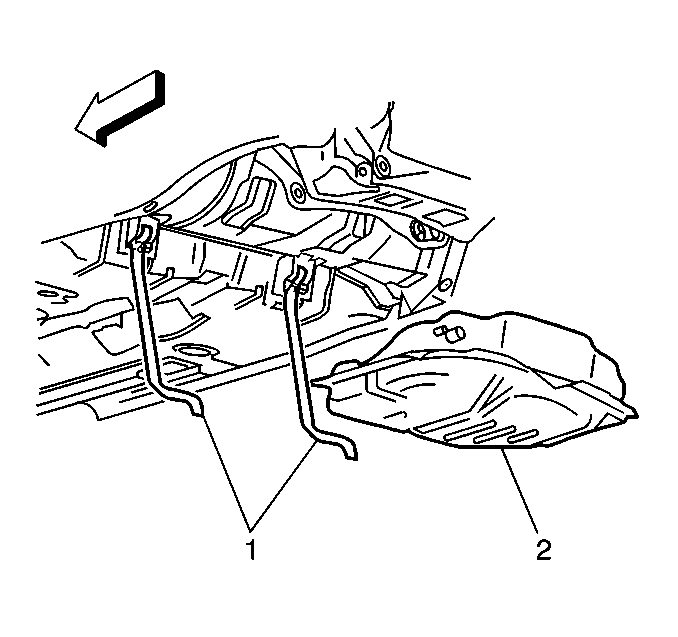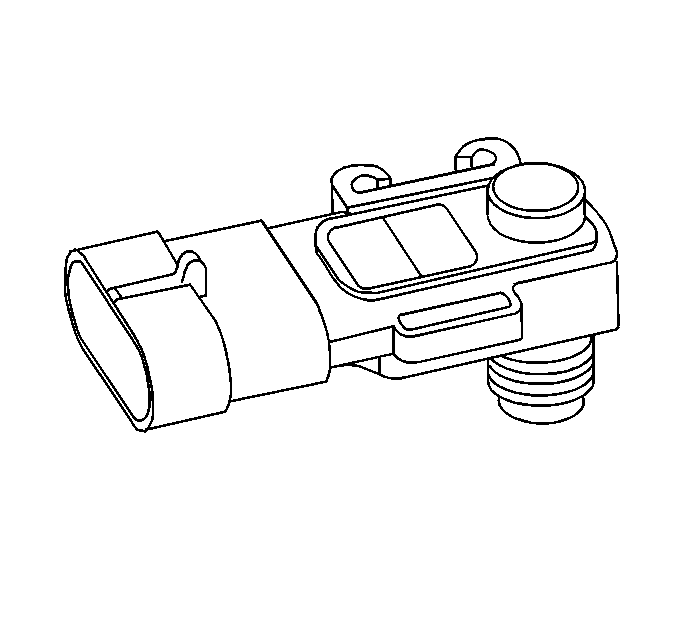Removal Procedure
Important: Do Not attempt to repair sections of nylon fuel pipes. If the nylon fuel pipes are damaged, replace them.
- Relieve the fuel system fuel pressure. Refer to the Fuel Pressure Relief .
- Drain the fuel tank (2). Refer to Fuel Tank Draining .
- Raise the vehicle.
- Remove the fuel tank filler pipe EVAP pipe from the fuel tank EVAP pipe.
- Remove the fuel tank filler pipe from the fuel tank.
- Remove the quick-connect fittings at the fuel tank. Refer to Servicing Quick Connect Fittings .
- Remove the rubber exhaust pipe hangers in order to allow the exhaust system to drop slightly.
- Remove the fuel tank strap attaching bolts which retain the fuel tank straps (1), with the aid of an assistant, support the fuel tank (2).
- Lower the fuel tank enough in order to disconnect the fuel sender electrical connector and remove the fuel sender retaining clips.
- Remove the EVAP pipe from the rear of the fuel tank.
- Remove the fuel tank from the vehicle and place the fuel tank in a suitable work area.
- Remove the fuel tank pressure sensor electrical sensor connector.
- Remove the fuel tank pressure sensor hold-down retainer.
- Remove the fuel tank pressure sensor from the fuel tank.


Installation Procedure
- Install the new seal into the fuel tank
- Install the new fuel tank vapor pressure sensor into the fuel tank.
- Re-connect the fuel tank vapor pressure sensor retainer.
- Install the electrical connector.
- Position and support the fuel tank (2), with the aid of an assistant.
- Install the EVAP pipe to the rear of the fuel tank.
- Install the fuel sender electrical connector.
- Install the fuel sender retaining clips.
- Install the fuel tank retaining strap (1) attaching bolts.
- Install the quick-connect fittings. Refer to Servicing Quick Connect Fittings .
- Install the fuel tank filler pipe EVAP pipe to the fuel tank.
- Install the fuel tank filler pipe to the fuel tank.
- Install the rubber exhaust pipe hangers.
- Lower the vehicle.
- Add fuel to the fuel tank.
- Install the fuel tank filler pipe cap.
- Install the negative battery cable.
- Inspect for leaks.


Tighten
Tighten the fuel tank retaining strap bolts to 34 N·m (25 lb ft).
Notice: Use the correct fastener in the correct location. Replacement fasteners must be the correct part number for that application. Fasteners requiring replacement or fasteners requiring the use of thread locking compound or sealant are identified in the service procedure. Do not use paints, lubricants, or corrosion inhibitors on fasteners or fastener joint surfaces unless specified. These coatings affect fastener torque and joint clamping force and may damage the fastener. Use the correct tightening sequence and specifications when installing fasteners in order to avoid damage to parts and systems.
Tighten
Tighten the fuel tank filler pipe EVAP pipe hose clamp to 2.8 N·m
(24.8 lb in).
Tighten
Tighten the fuel tank filler pipe hose clamp to 2.8 N·m (24.8 lb in).
| 18.1. | Turn the ignition switch to the On position for 2 seconds. |
| 18.2. | Turn the ignition switch to the Off for 10 seconds. |
| 18.3. | Turn the ignition switch to the On position. |
| 18.4. | Check for fuel leaks. |
